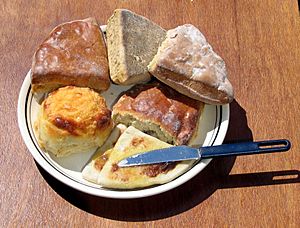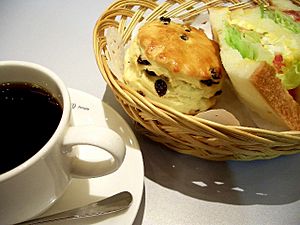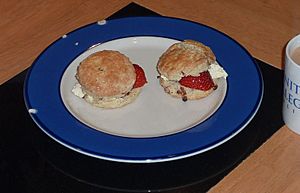Scone facts for kids
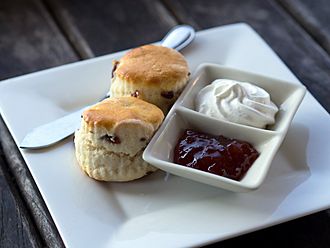
|
|
| Type | Cake |
|---|---|
| Place of origin | United Kingdom |
| Main ingredients | Wheat, barley, or oatmeal |
A scone is a small, tasty baked good. It's a type of bread that is often shaped like a triangle or a round circle. Scones are similar to crumpets or muffins.
They are made from wheat, barley, or oatmeal. Baking powder is added to make them rise and become fluffy. Scones look a lot like North American biscuits, and their recipes are quite similar.
Sometimes, scones have yummy additions like raisins, currants, cheese, or dates. In the United States, scones often have sweeter fillings such as cranberries, chocolate chips, or nuts. You can often find them in coffee shops, especially in the British Isles. Many people think scones taste best when they are hot and fresh from the oven, served with melting butter.
Contents
History of Scones
Scones are strongly linked to England, Scotland, and Ireland. However, no one knows for sure which country first invented them. The first time the word "scone" appeared in print was in 1513. It was in a translation of a poem called The Aenaid by a Scottish poet named Gavin Douglas.
Scones are connected to an old Welsh tradition. People in Wales used to cook small, round yeast cakes on hot stones. Later, they started using griddles instead. The very first scones were made with oats and cooked over an open fire. Today's scones are more like American biscuits. They are usually made with wheat and baked in an oven.
Types of Scones
British scones are often a little sweet, but they can also be savoury (not sweet). They often have raisins, currants, cheese, or dates mixed in.
In Scotland and Ulster, you can find savoury scones like soda scones (also called soda farls). There are also potato scones, known as tattie scones. These are thin, savoury pancakes made with potato flour. Tattie scones are usually fried and served as part of a full Scottish breakfast.

The griddle scone (or "girdle scone" in Scots) is cooked on a griddle on the stove. It's not baked in the oven. This type of scone is also popular in New Zealand.
Other common types include the dropped scone or drop scone. This is like a pancake, made by dropping the batter onto a frying pan. There's also the lemonade scone, which uses lemonade and cream instead of butter and milk. A fruit scone is a plain round scone with fruits like currants, sultanas, or cherries mixed into the dough. Some scones are made with cream instead of milk to make them lighter and flakier.
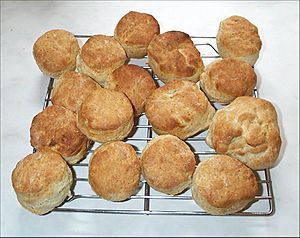
You might also find savoury scones with cheese, onion, or bacon mixed in or on top. Scones are often served with butter, jam, and cream. Sometimes, strawberries are used too.
Scones Around the World
Europe
In 2006, scones were chosen to represent the Republic of Ireland for Café Europe. This event happened during the Austrian Presidency of the European Union. The United Kingdom chose shortbread for the same event.
In Hungary, there is a pastry called "pogácsa" that is very similar to British scones. This name is used in several nearby countries. Pogácsa is almost always savoury. It is served with different seasonings and toppings, like dill and cheese.
Australia
Pumpkin scones are popular in Australia. They are made by adding mashed cooked pumpkin to the dough. Date scones, which have chopped dried dates, are also found there. Another old way to cook scones, especially in colder weather, is to deep-fry them. When fried, they are called "puftaloons."
New Zealand
Cheese scones are a popular snack in cafes and tea shops in New Zealand. They are often served toasted with butter. They are even in the famous Edmonds Cookery Book and are a part of kiwiana (things that are special to New Zealand).
North and South America
Round British scones can look like North American biscuits. However, scones traditionally use cold butter, while biscuits often use other types of fat. Also, scones are usually sweet and eaten with coffee or tea. Biscuits are more like a bread roll and are often served with breakfast in the American South.
In recent years, "scones" have become popular in coffee houses in the US. These American "scones" are often sweet, with fruit like blueberries or sultanas. They might also have cinnamon or chocolate chips. US "scones" are usually closer to British Rock cakes. They are often heavy, dry, and crumbly, and shaped like a triangle or irregularly.
In Utah and southern Idaho, the local "scones" are different. They are similar to Native American frybread or New Orleans beignets. These are made from a sweet yeast dough with buttermilk and baking powder. They are fried instead of baked. People usually eat them with butter and honey or maple syrup.
Scones are also very popular in Argentina and Uruguay. They were brought there by immigrants from Ireland, England, Scotland, and Wales. People usually enjoy them with tea, coffee, or mate.
Japan
US-style scones became popular in Japan about ten years ago, thanks to American coffeehouses like Starbucks. Now, you can find them in many coffee shops and bakeries. Like in the US, these Japanese "scones" are similar to Rock cakes. They are heavy, dry, and crumbly, often with fruit like blueberries or chocolate chips. However, raisins or sultanas are not very common.
A few restaurants and tea shops in Japan specialize in British food. They sell real British scones, often as part of a Cream tea. For example, the "Afternoon Tea" chain offers them.
Other Uses of the Word "Scone"
In Scots, the word scon means to flatten something or hit it with an open hand. A "scon-cap" or "scone-cap" is a man's flat cap.
In Australia, "scone" can be a slang word for the head, usually meaning the top part.
Images for kids
See also
 In Spanish: Scone (pan) para niños
In Spanish: Scone (pan) para niños


